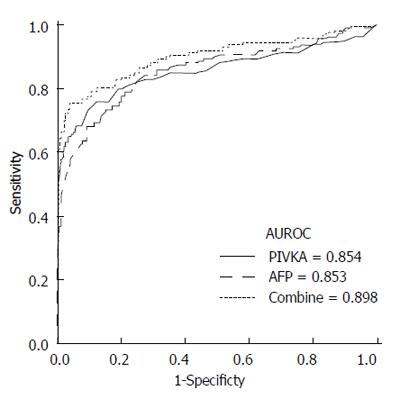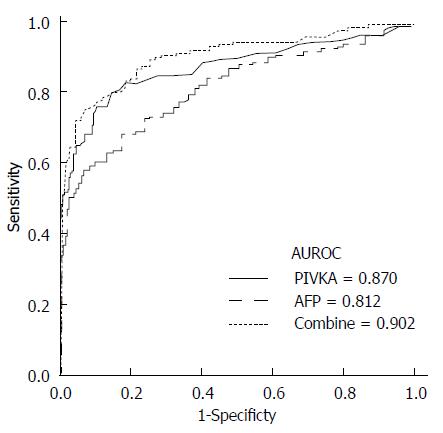Copyright
©The Author(s) 2015.
World J Gastroenterol. Apr 7, 2015; 21(13): 3928-3935
Published online Apr 7, 2015. doi: 10.3748/wjg.v21.i13.3928
Published online Apr 7, 2015. doi: 10.3748/wjg.v21.i13.3928
Figure 1 Receiver operating characteristic curves comparing prothrombin induced by vitamin K absence-II, alpha-fetoprotein and a combination of alpha-fetoprotein and prothrombin induced by vitamin K absence-II in patients with hepatocellular carcinoma vs those with nonmalignant chronic hepatitis B.
The AUROC curves for PIVKA-II, AFP, and Combination are indicated in the inset. P = 0.965 for AFP vs PIVKA-II, P < 0.001 for combination vs PIVKA-II and P = 0.037 for combination vs AFP. PIVKA-II: Prothrombin induced by vitamin K absence-II; HCC: Hepatocellular carcinoma; AFP: Alpha-fetoprotein.
Figure 2 Receiver operating characteristic curves comparing prothrombin induced by vitamin K absence-II, alpha-fetoprotein and a combination of alpha-fetoprotein and prothrombin induced by vitamin K absence-II in patients with hepatocellular carcinoma vs those with liver cirrhosis.
The AUROC curves for PIVKA-II, AFP, and Combination are indicated in the inset. P = 0.042 for AFP vs PIVKA-II, P = 0.001 for combination vs PIVKA-II and P < 0.001 for combination vs AFP. PIVKA-II: Prothrombin induced by vitamin K absence-II; HCC: Hepatocellular carcinoma; AFP: Alpha-fetoprotein.
- Citation: Seo SI, Kim HS, Kim WJ, Shin WG, Kim DJ, Kim KH, Jang MK, Lee JH, Kim JS, Kim HY, Kim DJ, Lee MS, Park CK. Diagnostic value of PIVKA-II and alpha-fetoprotein in hepatitis B virus-associated hepatocellular carcinoma. World J Gastroenterol 2015; 21(13): 3928-3935
- URL: https://www.wjgnet.com/1007-9327/full/v21/i13/3928.htm
- DOI: https://dx.doi.org/10.3748/wjg.v21.i13.3928










